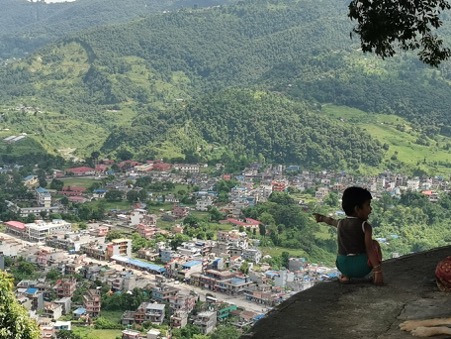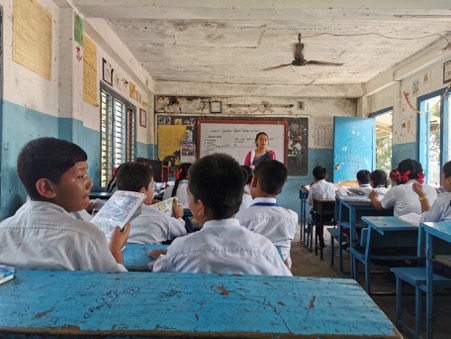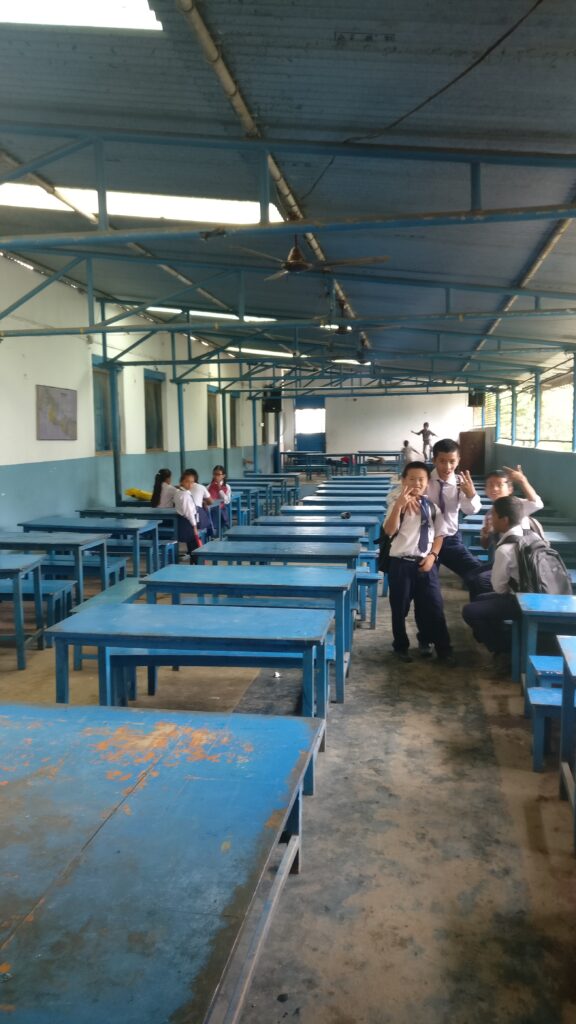I was asking myself what are schools like in Nepal the year I decided to volunteer with a Nepalise charity. It was with a charity called the Mountain Trust during the summer after the second year of my undergraduate degree. Mountain Trust organises health, education and human rights projects to support underprivileged and vulnerable Nepal communities. I was involved in the civic education programme, and my main project was teaching at Bal Mandir Secondary School in Pokhara.
I spent my first morning at the school in the headmaster’s office. My memory of that morning is filled with teas, the sweetest I have ever had. After discussions, I was assigned to teach Year 5 children social sciences under the supervision of a young teacher named Kusum.
Primary school in Nepal consists of Years 1 through 8, and schools run from Sunday to Friday. At Bal Mandir School, English was the language used in most textbooks, apart from the subject, Nepalese. Teachers mainly gave out instructions in English and sometimes supplemented it with Nepalese.

I started to question school textbooks
I asked to observe some classes before I started to teach. Sitting at the back of the classroom like a giant in a Year 5 classroom, I got quite a lot of attention. Children turned their heads around and looked at me with curiosity from time to time. When I met their eyes and smiled, they immediately looked away and shared a giggle with whoever was sitting nearby.
It was interesting to observe that the main way teachers taught was by asking students to read the school textbook aloud and recite some important parts. This method was used in different subjects, including sex education. Hardly any teacher would encourage the students to engage in class content actively and ask them intellectually stimulating questions.
I was shocked by the quality of the content when I was preparing for a lesson based on a textbook chapter called ‘Don’t forget our culture.’ The grammatical mistakes were very distracting. The arguments were not supported by evidence but merely personal opinions and made-up facts.
One paragraph read:
“People have started to adopt foreign culture due to communication technology. So, our culture is on the verge of extinction. Mostly young people are forgetting their native culture, costumes, festivals and lifestyles…Nowadays, if we look at the boys and girls around the towns, cities, it seems we are not in Nepal. They look so different that we are ashamed. These things can prove the growing attraction of Nepalese youths to foreign culture and fashion.”
I couldn’t believe that this was the content that the children would be receiving, usually without question. Instead of creating fear and shame as the textbook wanted the teachers to do, I thought I had to teach the children something else.

Yes, school textbooks can be wrong
I walked into the classroom the next day. Before I said anything, I wrote on the board: “Question the textbook”. Then I underlined it and wrote: “The main objective of this lesson is to think about how much we agree with what the textbook has said”.
The students stared at me. Their eyes were filled with surprise. No more reciting and memorising the textbook? And…textbooks could be wrong?
After reading the textbook and a few minutes’ discussion among themselves, many children put their hands up. They told me that it’s unfair to say that young people have forgotten their culture. I listened as the children passionately told me about the festivals they were looking forward to, the costumes they would wear to different occasions, the food they love. Some children even showed me the traditional dances they do with Nepalese music. Other students pointed out that they do enjoy Western music and films, but it’s hard to conclude without any evidence that Nepalese culture is on the verge of extinction.
The students had the power to question things that they were fed, but they were not usually in an environment where they were encouraged to do so. I doubt that my short stay as a volunteer has made any structural changes, but I hope the passion and courage to question that the children demonstrated during that lesson will be something they remember and hold on to from time to time.

Another lesson I taught was nutrition. I made a simple PowerPoint presentation that showed some pictures of vegetables. There was no projector in the classroom, so I brought my laptop. The moment I opened it to show the presentation, I heard a loud “Wow” erupt across the classroom.
The children’s eyes were shining with excitement as if they saw something beyond the ordinary, the wonders of the world. Wait, did I put on the wrong PowerPoint? I immediately checked my laptop to make sure that it was just a picture of broccoli on display… and it was.
I later realised that being taught using a laptop and PowerPoint was not something they experienced frequently. There was only one room in the school equipped with a projector. Only students in higher years had the opportunities to be taught in that room.
I looked at the children with a big smile and slowly walked around the classroom with my laptop resting on my palms. The children eagerly leaned forward to get a good look at every single picture I put on the PowerPoint.
“Milk! Pepper! Broccoli! Wow!”
So, what are schools like in Nepal?
Students at the school generously showed their affection and welcome. They would surprise me with small gifts such as self-made paper roses, a sachet of mango juice powder or pickled plums from home. The teachers’ level of enthusiasm was also high. Some offered to make me a set of traditional Nepalese costumes; others offered me a marriage with their brother!
The affection and love I received were visibly manifested between teachers and students. I often saw younger boys and girls whispering into a teacher’s ears or even pinching a teacher’s face with a cheeky giggle.
I rarely saw Kusum walking around the school without a smile. She told me: “the children can tell us about things they are not happy with at school or at home. A lot of them are from tough family backgrounds. Sometimes they can be too loud and create chaos, but it does not mean that they are bad. They are just children, and I love them for that.”
But is love enough for a child to thrive?
Thank you for visiting our blog. Our vision here at Books2All is a world where every child finds the books that help them reach their true potential. If you have spare books in good condition at home that you think might be appropriate for school children, please sign up for our app’s pre-release waiting list. If you represent a school, please register to receive books for your students.

